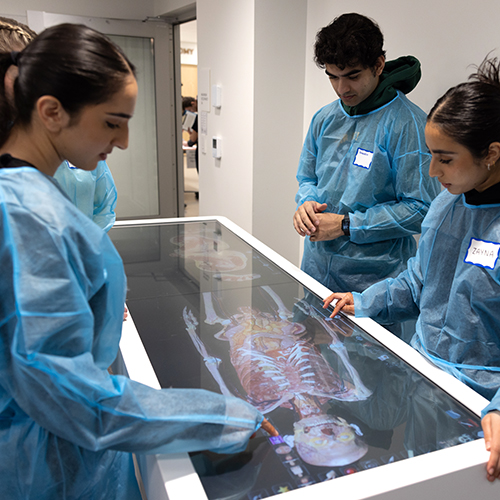You know the feeling. After a long flight and a drastic time change, you’re trying to make it through the afternoon in a new city. Then—wham!—you’re hit with a
wave of fatigue.
Jet lag is familiar to travelers. But we’re not the only ones who experience that unwelcome condition, according to Horacio de la Iglesia, assistant professor of biology. Rats have a similar response when daily cues of light and darkness are altered. The problem, explains de la Iglesia, is that the body’s circadian rhythms remain loyal to an internal clock even when one’s environmental cues change.
De la Iglesia studies circadian rhythms in a variety of animals, including rats,
mice, hamsters, and crabs. These rhythms are generated by an internal clock that regulates hormones, mood, sleep, and other body functions throughout the day.
“All living organisms have circadian clocks,” explains de la Iglesia. “When something is widely spread across species, it is usually very useful from an evolutionary point of view.” Although this internal clock may be an irritation for travelers, its actions—such as releasing hormones that provide wakefulness just before the sun rises—can be important to the survival of many species.

Previous research has shown that circadian rhythms persist regardless of the presence of external cues. If you put a person in isolation for days on end, with no indication of when it is day or night, that person’s internal clock will continue to run on schedule. Under normal conditions the clock will be in time with the outside world, but when there is a disconnect between one’s internal clock and external cues, as experienced by long-distance travelers or night-shift workers, the clock can be out of sync with the environment. This also makes rhythms in an individual become out of sync with each other, a condition called “internal desynchronization.”
In mammals, the biological clock has been linked to a specific region in the brain—the suchiasmatic nucleus within the hypothalamus—although virtually all organs have clocks that assist the central clock. These clocks act synchronously to, for instance. release hormones that help you wake up in the morning or become sleepy at night. When travelers fly to a different time zone, it takes a few days for the circadian system to adapt; their biological clock continues to release hormones based on the old time zone. So if you find yourself wide awake at 3 a.m. in Istanbul, feel free to blame your suchiasmatic nucleus.
To understand the long-term effects of internal desynchronization, de la Iglesia’s research team is looking at what happens to rats that are desynchronized, which mimics what happens in humans. The team exposes the rats to artificially short light/dark cycles and studies the body’s response.
“When you induce desynchronization in this way, some rhythms are able to synchronize to the environment but others cycle out of synchrony,” says de la Iglesia. “So now you have an animal with two sets of rhythms that are sometimes in phase and sometimes out of phase. It can be very detrimental to the animals.”
And equally detrimental to humans. “There is a lot of data showing that shift workers have a higher incidence of diseases such as cancer and cardiovascular and gastrointestinal disorders,” says de la Iglesia. “This is not just because they may be sleep deprived but also because their internal rhythms are not having a normal relationship with each other. My hope is that our research will help explain why people exposed to these schedules experience more disease.”
De la Iglesia is also studying circadian rhythms in crabs, an area of interest since his days as an undergraduate in Argentina. At that time, de la Iglesia noticed crabs burrowing into the sand and staying in those chambers before the tide came in. He wondered if they were responding to environmental cues or an internal clock.
“It turns out they do both,” he says. His lab is studying crabs in tidal zones in the Northwest. What makes them intriguing, says de la Iglesia, is that the crabs are exposed to two environmental cycles: the light and dark cycle, and the tidal cycle. “In a lab, away from environmental cues, the crabs’ internal clocks still tick with the period of the tides,” he says. “The question is, if you have a circadian clock and you’re in need of a new timing system relating to tides, can you use the same clock or do you use a new set of genes to deal with the tides?” To answer that, de la Iglesia is trying to identify genes and neurons that might be involved in generating rhythms in synchrony with tides or with the light/dark cycle.
With his extensive research into circadian rhythms and internal desynchronization, does de la Iglesia have a technique for avoiding jet lag when he must travel across time zones?
“I just go cold turkey,” he says with a shrug.
More Stories

The Impact of Anatomy Lessons
Anatomy for Change, a program for students underrepresented in healthcare careers, provides opportunities to spend time in an anatomy lab.

What the Sky Teaches Us
Brittany Kamai, an astrophysicist with knowledge of Pacific Islanders' Indigenous navigation using the sky, is teaching a new UW course, Pacific Indigenous Astrophysics.

Lifting Marginalized Voices — from Ancient Rome
"Interesting, frustrating, and necessary,” is how Sarah Levin-Richardson, professor of Classics, describes her research into the lives of enslaved individuals in the ancient world.